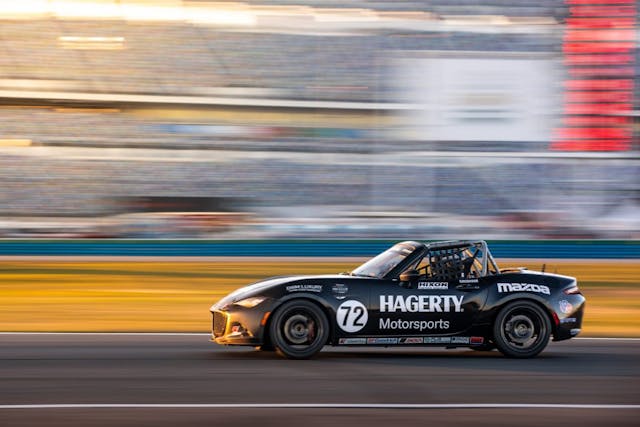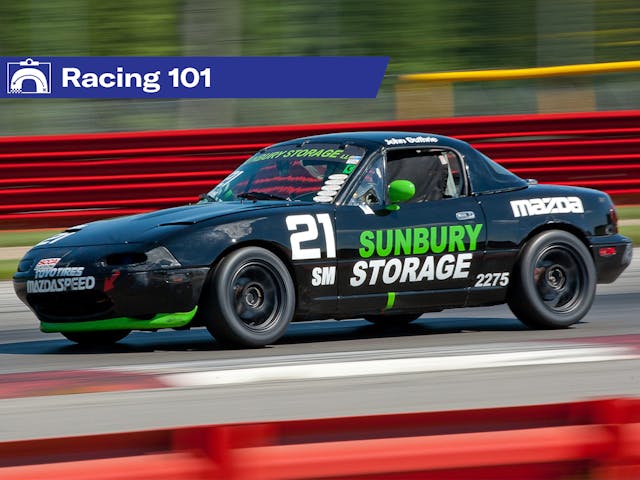Racing 101 #1: Ross Bentley on momentum
Ross Bentley is a professional driving coach, sports car racer, and author of the bestselling Speed Secrets book series. He will join us each Monday to explain and dissect aspects of high-performance driving. Sharpen those pencils, take a seat, and speak up in the comments below. Class is in session.
As a kid, I loved merry-go-rounds. You know, the ones where you run and push, run and push, run and push, then jump on, hang off the outside, and feel the g-loads rushing your blood and internal organs to one side of your body? Those were especially fun if my brother came with me to the playground. He provided extra power.
He also called them “barf machines.”
I hated it when the merry-go-round began to slow, losing its momentum. Slowing meant two things. First, the g-load dissipated—a terrible thing for a g-load junkie. Second, I had to jump off and push again; at that point, my brother had no energy whatsoever.
Cars are the same. I hate it when they lose momentum.
Imagine whizzing through a 90-degree right-hander on a race track in a Miata, the ultimate “momentum car.” Right at the point in the corner where you’re at the minimum speed—that moment right after easing your foot off the brake pedal, and before you’ve begun to squeeze on the throttle—your 138-horsepower rocket is at 49 mph.
On the next lap, as you enter the corner, you begin easing your foot off the brake pedal just a little bit slower. You hang on the brakes a touch longer, slowing your Miata to 47 mph.

This instance is a bit like when my merry-go-round slowed to the point where I could jump off it without being thrown into the swings. (We hated those swing kids, didn’t we?) Because of your over-braking, your Miata loses momentum.
Ahh, but that’s okay if you’re just two mph slower, right?
You can put the hammer down a little harder. In fact, you try to press the gas pedal down and through the floor. Still, your speed down the following straightaway is not what it once was. Your lack of momentum hurts your cornering speed and your speed down the straight. The loss of momentum in a car like a Miata can result in a drastic loss of top-end speed on the next straight. In fact, it might take another lap or two of pushing the merry-go-round to get it back up to speed.
Now, imagine driving a C8 Z06 Corvette through that exact same corner. And let’s say your minimum speed (what we call “min speed”) at the same spot in the corner is 47 mph, just like the over-slowed Miata.
With 670 horsepower under your right foot, you’re using a sledgehammer rather than a kid’s toy hammer. In a near-instant, your internal organs are heading into the back of the seat, and you’re rocketing down the next straightaway.

That’s the difference between a momentum car and what we can refer to as a “point-and-shoot” car. With a momentum car, being fast is all about maintaining speed. With a point-and-shoot Z06, for example, being fast is all about regaining speed.
Different drivers have different driving styles, too, with some being more momentum-type drivers, and others using a point-and-shoot style. If you fall into the latter category, your min speed is not as important as how early you can get to full throttle when exiting out of corners; the goal is to regain speed by using the engine’s torque and horsepower to reaccelerate the car. If you’re a momentum driver, on the other hand, your goal is to slow your car as little as possible, to maintain its speed, because it has comparatively little torque and horsepower.
For momentum driving, the line through corners uses as large a radius as possible. This is important to unlocking maximum momentum. The smaller the radius we drive, the slower we have to go, so we try to flip that around to keep our momentum up.
With a point-and-shoot style, the driver tends to brake later, driving deeper into the corner before turning comparatively sharper (using tighter, smaller radius) to get the car pointed in the direction of the next straightaway as early as possible. They can then take advantage of their car’s acceleration capabilities.
In thinking about the difference between momentum and point-and-shoot cars, the Miatas of the track world have more cornering power than they do acceleration power. Point-and-shoot cars are the opposite. Think of an early Cobra, with tons of engine power but relatively less cornering ability.

Contrary to what I said about the Z06, I believe all cars, no matter how much acceleration ability they have, can be momentum cars. Think about it: Whether you’re driving a Miata or a Corvette, you would much rather begin accelerating out of a corner from 49 mph than 47. (Sure, if you started from 47 mph in both cars, it would be easier to make up for over-slowing in the Vette.)
Your min speed is not a one-sided factor to consider and manage when you’re driving: What matter is not just what your speed is, but where in the corner you hit it, and how much time you spend at it. We drivers are making these complex calculations and comparisons in our minds while traveling the length of a football field in about the time it takes to say, “length of a football field.”
Oh, and when someone asks a question about favorite track-driving cars, don’t be surprised if the most common answer is “Miata.”
Why? Because it’s a momentum car, and when you learn to carry momentum through corners, you’ll be faster in any other car you ever drive. It’s the ultimate training tool. Did you over-slow the car? Was your radius too tight? Get it right and you’ll have oodles of momentum.
The feeling of your blood and internal organs being pushed to the other side of your body, like on that merry-go-round, is what makes track driving so much fun. Cue the barf machine.

***
Check out the Hagerty Media homepage so you don’t miss a single story, or better yet, bookmark it. To get our best stories delivered right to your inbox, subscribe to our newsletters.
Via Imola



OMG thank you for confirming what I’ve been saying for years.
As for the sideways g-loading: Diving into the boot at WGI, before the Bus Stop Chicane was there. Whee!
Great article, thank you. Do these principles apply in Autocross where one is frequently taught to drive the shortest distance on the course versus taking the larger radius?